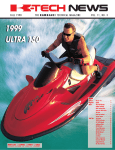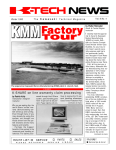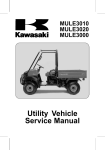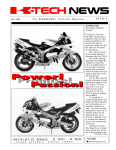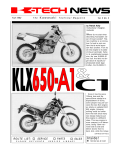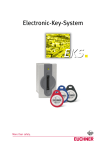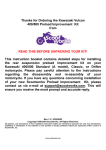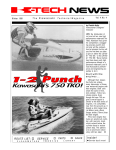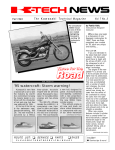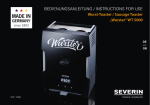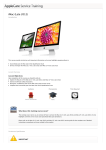Download K-Tech News Vol.8 No.4
Transcript
WINTER 1995 THE KAWASAKI TECHNICAL MAGAZINE VOL. 8 NO. 4 INSIDE Features Micro-K Regional News Tech Tips ‘96 Cruisers . . . . . . . . . 2 Older Vehicle Parts . . . 3 Update. . . . . . . . . . . 4 Latest Information . . . 5 lnstall Inlet Guides . . . 6 ZX-7RR Fork Tool. . . . 6 ZXi Trim Cables . . . . . 7 Oil Drum Storage. . . . 7 Vulcan 800 Plugs. . . . 8 KX Fork Oil levels . . . 8 KLF/KEF Starting . . . . 9 MULE™ Noise. . . . . . 10 KAF620 Cooling . . . . 11 increase air velocity at low rpms, for improved low speed carburetion and performance. The exhaust system’s internal diameter is also reduced in size by 6.4mm to increase exhaust gas velocity at low rpms, also contributing to improved low speed performance. A reduction in compression ratio (from 10.8:1 down to 10.2:1) and a 26% increase in flywheel effect combine to smooth out the power delivery. In the transmission, second and third gear ratios are slightly taller to match this new powerband. Vulcan 800 Classic The Vulcan 800 Classic follows on the heals of the popular Vulcan 800 introduced last year. Although initially the two motorcycles seem to be completely different, closer examination reveals that they share an identical chassis and engine. The transmission is revised slightly, however, with lower first and second gear ratios and a final drive ratio that is about 14% taller for less engine rpms at cruising speeds. The transformation to classic styling is achieved by carefully changing a few key components. The most obvious change is up front where a fat 16-inch front wheel replaces the skinny 21inch wheel found on the standard Vulcan 800. To complete the front Boasting form and function, cruisers are much more than meets the eye! by Patrick Kelly Training Development Coordinator Market trends indicate that long, low and chromecovered motorcycles, commonly referred to as “cruisers,” are becoming more and more popular. 1996 brings nine cruiser models from Kawasaki, including four all new models. Since you will probably be seeing more of these chromed customs in your shop, let’s take a closer look. Vulcan 500 LTD The Vulcan 500 LTD is all new this year. And from the first look you can tell that the styling is completely different. The seat height is lower, the wheelbase longer and the rake is kicked out farther to give it that low and lean look. But the engine externally appears very similar to the standard Vulcan 500 engine. However, inside the engine there are many differences, all designed to give the engine more lowend power and torque. Both intake and exhaust cam duration are reduced by 16° to improve efficiency at low rpms. To go along with the increased efficiency at low rpms, the LTD gets smaller carburetors, going from 34mm to 32mm. The smaller carburetor bores WINTER 1995 2 K-TECH NEWS end transformation, a 24mm shorter front fork with outer covers is used along with a large classic style front fender. A large classic style fender is used out back as well. Other differences include a twopiston front brake caliper instead of a single piston caliper; lower, wider handlebars; a new seat that looks like a two-piece design but is one piece; a larger headlight and a different taillight. Vulcan 1500 L The Vulcan 1500 L is not, strictly speaking a new model, having been introduced in Europe two years ago. The 1500 L is technically identical to the standard 1500, but a few cosmetic differences– chrome spoke wheels instead of cast aluminum wheels and a wide flat “drag” style handlebar instead of a pull back handlebar – give the 1500 L its own custom look. Vulcan 1500 Classic At first glance, the Vulcan 1500 Classic appears all new; and in this case, it’s true, as the Classic edition of the 1500 features an all-new chassis and a thoroughly restyled Continued on page 12 K-TECH News Vol. 8 No. 4 Winter 1995 K-TECH News Staff Micro-K Publisher Kawasaki Tech Services Older Vehicles: Are the parts still available? Publications Manager Don Church by David Pyle Parts Publications Specialist Executive Editor Gary Herzog Editor-in-Chief Gregg Thompson Communications Editor Patrick Kelly Regional Editors North and East Fred DeHart Central and South Walter Rainwater West Robert Taylor Contributors Shannon Beeson, Dave Behlings, Keith Pestotnik, David Pyle, Ray St. John Graphics/Production Graphic Art Gregg Thompson Photography Dave Corey, Rich Cox, Kevin Wing Copy Editor Pat Shibata Production Holland Marketing Services ©1996 Kawasaki Motors Corp., U.S.A. All rights reserved. Published by Kawasaki All suggestions become the property of KMC. Sending a service suggestion gives Kawasaki permission to publish and/or use it without further consideration. Specifications subject to change without notice. does not mean that the part is still available. Your best bet is to do an Item Status Inquiry an K-Share or call your Distribution Center. This way, you can verify the parts status as well as inventory level. If the inventory level is low, it might be a good idea to inform your customer of this, and that you may or may not be able to get the part. If the part is cancelled, all hope is not lost. Use K- As time goes on, more customers are purchasing Share to run an ad an the Item Locator Service. This is and rebuilding “vintage” bikes or, in some cases, just also a great way for dealers to move some alder holding an to their favorite motorcycle, ATV, or Jet Ski inventory. I talk to dealers all the time who procure watercraft, a bit longer. The result is that more and hard to find or cancelled parts through the Item Locator more customers are looking for parts for older vehicles. Service. Let’s look at some ways that can help you avoid telling Part of good customer service is good intentions an a customer that you can get a part and then finding out your part. Even if you can’t get the part that the that the part is no longer available. customer is looking far, taking the few extra steps to Don’t just look in the Retail Price Guide. The price avoid an unhappy customer is well worth your time. guide is only accurate up to the day it was printed. Just That customer will return for other parts down the road because the part number looks good in the price guide if they know you are willing to go the extra mile. ABS Training Materials Now Available ABS Training Manual especially important to European consumers. Anti-lock braking systems may be the wave of the future. But you probably don’t really care how many different bikes have antilock braking systems or who likes them. What you want to know is how to work on the one that just appeared in your shop. Anticipating this need, Kawasaki Service Training and Communications Department has just released a new video tape and a training manual which explain how the, by Ray St. John Supervisor, Technical Writing The Anti-Lock Braking System (ABS) on the newfor-'96 ZXll00-Fl is an important step forward for Kawasaki’s motorcycle technology. Anti-lock braking systems have been in use in automobiles for several years and are becoming more and more popular. Several brands of motorcycles offer anti-lock braking systems on chosen models, and they are WINTER 1995 3 K-TECH NEWS w anti-lock braking system works on the GPZll00 ABS, and what to check first if it doesn’t work. The video tape is 18 minutes long and one of the most important things it covers is how to read the selfdiagnosis feature of the system. The 21-page training manual also includes complete and detailed wiring diagrams. The video is available for $35.95 ($25.00 for Technical Training Video Club members) plus shipping, handling and applicable sales tax by calling (714) 770-0400, Ext. 2472. Members of the Kawasaki Technical Training Video Club have already received the video automatically. Dealer cost for the training manual is $6.95, and may be ordered under P/N 99964-0059-01. One copy of the training manual is included with the video tape, free of charge. w NORTH & EAST One of the most frequently asked questions at our training classes is Where can I find information on this particular Kawasaki product?” A good service technician needs to know where to find product information. It is not possible to remember every detail for all the products a dealership sells and services. The trick to saving SOUTH & CENTRAL The training season thus far in the south and central regions has been fairly WEST New West Region Training Instructor The big news in the west region this issue is the new west region training instructor, Mr. Robert Taylor. Robert comes to Kawasaki with over 20 years of experience in the industry. He spent the past time and maintaining credibility with your customers is knowing where to find the information needed. Listed are the materials I use daily for service and product information. How many are currently available at your dealership? Take some time to find them and familiarize yourself with their content. You will save time and dollars in the future! I wish you a happy and profitable new year, and I look forward to seeing you at one of Kawasaki’s training classes soon! Accessory Catalog Accessory Price Guide Assembly and Preparation Check Lists Assembly and Preparation Manuals Dealer Assistance Directory How We Stack Up K-FAX Document Retrieval System K-Tech News Magazine K-Tech News Microfiche Kawasaki Good Times Magazine Kawasaki Times Newspaper Marketing Bulletins Microfiche Check list Model Application Microfiche Model Recognition Manuals w Fred DeHart 201 Circle Drive N. #107 Piscataway, NJ 08854 (201) 469-1221 active, with most classes having good attendance. One of the classes that has not been offered yet but well worth attending is Product Update '96. 1996 brings numerous new and updated products to our line-up, such as the new 800 and 1500 Classic Vulcans, the new ZX-7R and ZX-7RR, the new GPZ 1100 ABS and, of course, the incredible new 1100 ZXi Jet Ski® watercraft. so if you want to know what is new about these products, or if you are just curious about the meaning of the new for '96 acronyms, KAIS and KATS, then be sure to take a look at our training schedule and pick an update class date that suits your schedule. We will get you up to speed on all the latest features and ready for the eight years at a leading technical training school where he designed and taught numerous courses related to all aspects of motorcycles, ATVs and personal watercraft. Most recently, he was director of the school’s marine program, which included outboards, sterndrives and, of course, all brands of personal watercraft. Robert’s extensive knowledge and background bring a new dimension to Kawasaki’s training program. Take advantage of Robert’s knowledge by signing up for a couple of training classes soon. WINTER 1995 w 4 K-TECH NEWS Owners Manuals Parts Bulletins Parts Microfiche Parts Price Guide Product Brochures Product Sales Guides Retail Sale Price Sheets Roads Magazine Sales Bulletins Service Bulletins Service Manuals Service Specifications Handbook Service Training Manuals Service Training Videos Special Tool Microfiche Team Green News Magazine Warranty Policy and Procedures Manual busy spring and summer months ahead. And while you are signing up for Product Update, be sure to sign up for any other classes that might help you fine-tune your skills. I hope to see you in class soon! w Walter Rainwater 6110 Boat Rock Blvd. S.W. Atlanta, GA 30378 (404) 349-2000 JUST A NOTE ... As you may know, Kawasaki Motors Corp., U.S.A. recently took over distributorship responsibilities for the seven “Rocky Mountain” states previously handled by Rocky Mountain Kawasaki (RMK). – Ed. New Tech Service Employees by Don Church Manager, Service Training and Communications ATV product lines. Prior to joining RMK, Keith spent 12 years in the field as a dealership technician while pursuing a successful racing career that included motorcycles, snowmobiles, ATVs and watercraft. As you can see, Keith’s diverse background and experience with Kawasaki give him a wealth of knowledge that will lead to success in his new position and will result in better products for Kawasaki customers. This is what’s referred to as a “win-win situation.” Welcome, Keith! from Kansas State University in 1992. Shannon enjoys racing Jet Skis and recently competed in the 1995 Skat-Trak World Finals at Lake Havasu City, Ariz., on his Kawasaki XiR. Welcome, Shannon! w Shannon Beeson, New KMC Hot Line Technical Shannon Beeson started work with Rocky Mountain Kawasaki in 1993 as a Kawasaki Support Technician. No stranger to most Kawasaki dealers in the RMK region, he had assumed most of the day-to-day functions of Kawasaki technical and customer support at RMK. He joined KMC in the fall of 1995 to work as a Product Support Specialist on the Kawasaki Technical Hot Line. Growing up in a familyowned Kawasaki Dealership in Western Kansas, Shannon gained much experience with the ATV and MULE™ product lines as well as street bikes and personal watercraft. In the midst of a busy work career, he graduated with a Bachelor’s degree in mechanical engineering Kawasaki’s telephone lines are being upgraded to accommodate new lines in order to offer better service for our dealers. This change will affect our K-FAX line. The number is being changed to: (714) 460-5663. This bulletin also has stickers attached with the K-FAX and Hot tine numbers you can put right on your phone. Please make a note of this change on your K-FAX materials. For more information on how to use K-FAX, refer to Service Bulletin GEN 95-01.—E d . NEWS FLASH!! Keith Pestotnik, New KMC Technical Services Employee In 1984, Keith Pestotnik joined Rocky Mountain Kawasaki-the former distributor for Kawasaki products in the seven-state region of the Midwest – working as Regional Service Manager for Kawasaki, Mariner and Force outboard motors, and Polaris snowmobiles and ATVs. His duties included dealer technical support, dealer technical training, warranty administration and consumer services. He later moved on to managing distribution functions for the parent company of RMK, Masek Distributing of Gering, Neb. In the summer of 1995, Keith relocated to Southern California with his family to join KMC as a Senior Product Quality Engineer. His special focus will be on the Kawasaki MULE™ and WINTER 1995 ATTENTION K-FAX USERS The '96 1100 ZXi has some important last minute additions! Two exciting new features have been added since the 1100 ZXi's introduction at the national dealer meeting in October. These features were originally slated for the '97 model, but through extra effort from KHI, these features will be on the '96 model. New to the industry is the Kawasaki Air Induction System, or KAIS. Air outlets at the aft ends of the inner strakes are Continued on page 6 5 K-TECH NEWS ’961100 ZXi Important Additions Continued from page 5 connected to tubes which go into the engine compartment. As the boat is under way, negative pressure generated at the end of the inner strake draws air from the engine compartment to the bottom of the hull. This reduces the drag between the hull and the water and also reduces resistance due to turbulence at the end of the strake. To prevent water from entering the hull if the boat capsizes, the tubes are crossed in the engine compartment. This assures that one end of the tube always remains above the waterline. KAIS reduces the drag and resistance between the hull and the water, meaning quicker acceleration and a higher top speed. And because this is accomplished without any modifications to the pump or engine, there is no added strain or TIPS FROM THE FIELD: stress to the engine or driveline components. Also added just in time for production is the Kawasaki Automatic Trim System, or KATS The system monitors engine rpm and adjusts the trim position accordingly for optimal acceleration from a standing start. As engine rpm rises past 2000, the system waits three seconds and then moves the trim nozzle up for 1.5 seconds, stopping at approximately the level position. When the engine rpm drops below 2000 for more than one second, the system brings the nozzle to the full down position. The KATS allows riders to concentrate on enjoying the 1100 ZXi's formidable acceleration without having to monitor the trim position. The system can be turned off by manually adjusting the trim or by a switch on the left handlebar. So be sure to take note of and let everyone know about these exciting new features found exclusively on the industry’s premier watercraft, the Kawasaki Jet Ski 1100 ZXi! Kevin Williams, from Walt’s Kawasaki in Lake Havasu City, Ariz., wrote to us with a time-saving suggestion for replacing the plastic jet pump inlet guide on our 1992-'95 750 watercraft. Kevin was looking for a You will have to drill a small hole in the intake guide to align with the hole in the intake grate. Bolt the modified intake grate to the hull and pump housing. Then, holding the intake guide in place, mark it through the hole in the grate. Then drill a hole in the guide the right size for the screw you are going to be using. You’ll have to make a small spacer (about l/2") to go between the intake guide and the grate. Then glue the guide in place using your special tool, spacer and screw to “special tool” to hold the intake guide in the proper position while the glue dries. He found the tool already in his shop: a discarded 750 jet pump intake grate. He removed the two outside vanes from the grate, but left the middle one in place. This left enough room to get his hands in to work on the guide. The grate already has a small hole that lines up right over the intake guide. hold it there while the glue hardens. We suggest you use the factory glue when installing one of these guides. You can order it from Kawasaki using P/N 99996-5501. Whenever we print a technical tip that was sent in from the field, we always send a $100 check to the person who submitted it. So Kevin Williams, thank you and the check is in the mail (really). Installing Jet Pump Inlet Guides w ZX-7RR Front Fork Tool The cartridge type front forks on the new ZX7-RR (ZX750-N1) require a special new tool to hold the cartridge during disassembly. If you expect to be working on any of these forks in the future, you should order one of these tools (P/N 57001-1396). w WINTER 1995 6 K-TECH NEWS w New Water Seal for ZXi Trim Cables by Dave Behlings Product Support Specialist Proper Storage of Oil Drums: What You Should Know by Gregg Thompson Product Support Supervisor Care should be taken when storing oil drums at your dealership to prevent water contamination of the oil. It is really best to store oil drums indoors to prevent exposure to moisture and extreme temperature changes. Unfortunately, many shops simply can’t spare the room inside their shop to store their drums. When drums are stored outside, water can collect on top from rain or snow. As a drum heats up and cools down from day to day, the oil and air inside housing has a small rubber boot at each end that the cable slides through as the trim is adjusted. Apparently, water can get past these boots in certain circumstances. For 1996 models with electric trim will have a new style boot on the pump end of this cable. The change will actually occur mid-year on some models. The new boot is an accordion-style one that fits tight (with zip ties) to the housing and the cable. It moves with the cable instead of the cable sliding through it. We expect this We’ve had some problems on the 1995 ZXi 900s and 750s with water leaking up the trim cable and into the trim control box. Water in the trim box always goes undetected and eventually damages one or more components, leaving the system inoperative. This cable around the bung. A 2x4 under one edge of the drum as shown here will do the job. Also, be sure to rotate your older drums to the front when new ones are delivered. Always use the oldest oil first. Even when stored properly, oil drums will collect moisture from the air if they’re stored long enough. expand and contract. As it expands, air is pushed out past the bung. As it contracts, whatever is around the bung gets pulled into the drum. If rain water has collected on top of the drum, that’s what gets pulled inside– and that’s bad. Roper storage can reduce the chances of this happening. CITGO Petroleum Corp. offers several suggestions. They recommend building a storage shelter where drums can be stored on their side, as shown in this illustration. The drums must be stored with the bungs in the position shown to prevent any contamination. If building a shelter is not in your near future, you should at least store the drums propped up and positioned so water doesn’t collect WINTER 1995 w 7 K-TECH NEWS design to be watertight. If you find water in the trim control box on a 1995 ZXi 900 or 750, install one of these new style boots (P/N 490163702) and zip ties (P/N 92037-1173) on the cable. The large end of this new boot will fit right over the existing small boot. Also, don’t forget to check the condition of the seals and O-rings on the wire harness connectors and cable mount at the box, and the large O-ring in the cover. These could also be a source of water in the trim box. w Vulcan 800 Cam End Plugs Leaking by Gregg Thompson Product Support Supervisor We‘ve had quite a few calls on the Hot Line lately about oil weeping from around the cam end plugs on VN800s. Often the servicing dealer replaces the O-rings on the plugs only to have it return in a few days with the same problem. We have had some of the problem plugs sent in to us for inspection. We discovered that they have some molding flash (a small rib of unwanted plastic) inside the O-ring groove. We believe this molding flash is preventing the O-ring from sealing completely. The solution is not to replace the plug, but to cut REMOVE MOLDING FLASH KX Fork Oil levels Revised KX125 and KX250 Service Manual Now Available There has been some confusion regarding fork oil levels on KX125s and 250s. This confusion usually results from comparing the oil level specs in the service manual with the ones in the owner's manual. If you compare them, what you’ll notice is that the specs are not the same! There is good reason for this and it’s important to understand. The service manual shows the oil level for a By the time you read this, the revised service manual for the 1994'96 KX125 and KX250 should be in stock. Order P/N 99924-1168-02. The revised manual includes 20 pages of information on the 1995 models, covering their differences from the '94s. Included ore new torque and locking agent specs; cable, wire and hose routing changes; as well as a FORK complete set of service specifications for the engine, transmission, final drive, covers the new 46mm forks and other service specifications. w – Ray St. John OIL LEVEL TABLE M ODEL OIL L EVEL (Spring Removed, Fully Compressed) ADJUSTABLE R ANGE 1994 KX125-K1 1994 KX250-K1 1995 KX125-K2 1995 KX250-K2 1996 KX125-K3 1996 KX250-K3 120±2mm 130±2mm 90~150mm 90~150mm 120±2mm 90~150mm 115±2mm 105~140mm and electrical system (with wiring diagram). The '96 model information fork that is first being filled after being drained or disassembled. After the fork has gone through its stroke one time, the oil level changes (rises) and a different oil level specification must be used. The owner’s manual shows the oil level for a fork that has been ridden. If this doesn’t make sense to you, read “Upside Down Forks-Oil Levels vs. Air Volume” in the Winter 1989 issue of K-Tech News. If you don’t have that issue, you can find it on grid D-3 of the March 1995 K-Tech News microfiche. Below is a reference chart with the service manual specs (newly assembled forks) for the 1994-'96 models. w – David Pyle New Fork Seal Driver for '96 KXs by Gregg Thompson Product Support Supervisor O-RING GROOVE out the unwanted plastic. Once you have cleaned up the groove in the plug, install a new O-ring and put it back in. w Again this year, Kawasaki has significantly changed the front forks on the KX250 (K3) and KX125 (K3). For '96, these inverted cartridge-type forks have 46mm inner tubes. This, of course, means it’s time for another fork seal driver for your tool collection. The part number for the new seal driver is 57001-1395. w WINTER 1995 8 K-TECH NEWS CLEAN THAT HUB One thing some mechanics overlook (especially at the races) when changing a KX bike rearbrake disc or sprocket is the mounting flange on the hub. Make sure you clean the surface of the flange that the disc or sprocket mounts against. Even a small amount of dirt on that surface can cause the disc or sprocket to warp when the mounting bolts are tightened. – David Pyle w KLF/KEF3OO Cold Weather Starting by Shannon Beeson Product Support Specialist Over the years, we have heard numerous complaints of starting problems on KLF300s in cold weather. Generally on these models, getting fuel into the combustion chamber is not the problem. The problem is getting the fuel that’s in there to ignite. Fuel enters the cold engine in liquid form. For combustion to occur, some of it must vaporize before the remaining liquid fuel wetfouls the spark plug. If you have a KLF300 that is getting fuel into the combustion chamber, but it will not start, consider the following items when diagnosing the unit: PLUG FOULING: Occasionally we hear of a KLF/KEF300 that will not start unless the customer replaces the spark plug each morning. The plug is usually sooty black and wet when removed. The black color is from a rich running condition that existed when the unit was last run. The sooted plug is then wet-fouled by the rich mixture created by the choke. An improper idle mixture screw setting or an incorrect fuel level can be FUEL QUALITY: Is the fuel in the unit fresh (recently purchased)? Many users of this type of product have their own fuel storage tanks. Often this fuel has been purchased some time ago (in the spring or summer). If so, the fuel should be removed from the unit and replaced with fresh seasonally blended fuel (don’t forget to drain the carburetor float bowl). Winter fuels are specially blended to enhance vaporization in cold weather. In addition, vaporization can be improved by increasing the cranking pressure in the combustion chamber. First, verify the engine condition by performing a compression and/or leakdown test. Then ensure the best possible cranking pressures by setting the valve clearances to the loose end of the specification. 3mm to CENTER OF HOLE SPARK QUALITY: The KLF/KEF300s have a battery ignition system. Anything that can be done to improve battery voltage will boost spark energy. Inspect the battery. Make sure it has been properly serviced, check its voltage, and do a load test on it. Additionally, a light viscosity oil in the engine will allow it to crank more easily in the cold. The starter will draw less current, allowing system (ignition) voltage to remain higher while cranking. Spark quality can be monitored by using an inductive timing light. WINTER 1995 the cause of the sooted plug. Make sure these are adjusted correctly. (Make sure the customer is not leaving the choke on while riding.) Do a quick check of the air cleaner element, too, just to be sure it isn’t dirty and restricting air flow. If you have adjusted the idle mixture screw and fuel level, but the unit continues to soot the plug at low speeds, check to see if the main fuel passage is feeding fuel at idle. With the inlet air duct removed 9 K-TECH NEWS and the engine idling, use a mirror and light to look in the carburetor throat. If you see fuel coming from the main passage around the needle, you should modify the slide to raise it slightly at idle. Raising the slide’s at-rest position will decrease the air velocity over the main fuel nozzle and reduce the tendency to draw fuel through it at idle. Do this, using the following procedure: 1 Remove the carburetor slide. 2 Drill a 5/64" hole at the ridge on the slide stop contact surface, 3mm from the slide body as shown. 3 Install a l/4" #4 sheet metal screw in the hole. The head of the screw should provide about 2mm added lift to the slide at idle. 4 Assemble the carburetor and readjust the idle mixture screw if needed. This modification should reduce the amount of fuel feeding through the main passage at idle, and as a result, extend plug life. Following the above procedures should ensure the best possible cold starting. And don’t forget that good engine condition is also very important. w Front Drive Train Noise on MULE™ 2510 by Keith Pestotnik Senior Product Quality Engineer Some KAF620-A's (MULE™ 2510) will develop an abnormal rattling noise from the front drive train. This noise is normally heard only in 2-wheel drive. It usually begins with the vehicle at a constant speed and light load when little or no noise. This reinforced rubber washer is thick enough that, when installed properly, it is compressed between the propeller shaft yoke and the differential. The pressure it applies to the yoke holds the yoke tight and prevents it from rattling. To get one of these washers, call the Technical Hot Line and ask for the NPN Noise Damper Washer for the KAF620-A. It currently has no Kawasaki part number. To install one, pull the front propeller shaft yoke off the front differential pinion shaft (see page 1122 of the service manual) and install the washer onto the pinion shaft, observing the following: torque is transferred through the front drive. Once the noise begins, it will probably continue until the vehicle stops or at least changes speed significantly. If this sounds like your problem, we have your cure. Actually, this problem was first discussed in the Winter 1993 K-Tech News, but we’ve learned more and would like to pass it on to you. This noise is caused by clearance between the splines in the propeller shaft yoke and the pinion shaft of the front differential. In early units, a special tape was put on the splines to dampen the noise. On later units, an oring groove and o-ring were added to the pinion shaft, but the noise still persists on some units. At KMC, we have developed and tested a durable washer/damper which, when installed on the front pinion shaft, will significantly reduce this WINTER 1995 l Remove and discard any tape or O-ring found on the pinion shaft. l Clean the splines in the yoke and on the pinion shaft and coat them with 10 K-TECH NEWS the toughest grease you have. (Bel Ray Waterproof grease or a good anti-seize compound will work well.) l Make sure the front and middle yokes on the propeller shaft assembly are aligned in the same plane. l Make sure all differential mounting bolts are tightened properly. l To compress the NPN washer, push the propeller shaft bearing housing to the left while tightening its mounting bolts. When done, check to make sure the new rubber washer is held tight between the propeller shaft yoke and the pinion shaft nut. If it is loose, the propeller shaft bearing housing must be moved farther to the left. To do this, you might have to enlarge or elongate the mounting holes in the frame. w KAF620 MULE™ Overheating by Keith Pestotnik Senior Product Quality Engineer It may not surprise you to know that air in the KAF620 MULE™ cooling system can lead to engine overheating. What might surprise you is how little air it takes to cause a problem, how easy it is to get that air into the system and how difficult it can be to get it out. A fairly small segment of air, if it reaches the water pump, can cause an air lock that will stop coolant circulation. If this occurs and the operator doesn’t notice the temperature warning lamp (or ignores it), serious engine damage can result. To prevent overheating, the cooling system must have all the air purged from it. Bleeding is difficult because there are several high points in the system, plus pockets in the water jackets of the engine that trap air. To fill the KAF620 cooling system, do the following steps in exactly this order: when coolant overflows the radiator. 4 Install the bleeder bolt in the intake manifold when coolant overflows there. 5 Install the carburetor hose when coolant flows from it. (Keep the end of the hose elevated until coolant runs out.) Note: No matter how carefully you follow steps 1 through 5, the system will still trap air (mostly in the engine’s water jackets). Continue the procedure. 6 Fill the coolant recovery tank to above the “F” mark. 7 Elevate the front end of the vehicle approximately 12 inches. Parking it on an incline is fine. 8 Start and run the engine at full governed REM, adding coolant at the filler neck as air escapes the system. Caution: If the governor is not adjusted properly, the engine could over rev and suffer internal damage. 9 Continue topping off the filler neck until the coolant begins to let off steam. At this point, the thermostat is beginning to open and you must install the filler cap very soon to avoid a geyser of hot coolant when the thermostat opens fully. 10 Disconnect the cooling fan at the bullet connector (black/yellow wire) just behind the gas pedal. Drive the vehicle until coolant begins to rise in the recovery tank. Note: If the temperature warning light comes on, reconnect the cooling fan immediately and allow it to cool down. Driving it on rough terrain will help jar loose any trapped air bubbles. Once the coolant begins to rise in the recovery tank, reconnect the fan wire. 11 Let the engine cool all the way down, making sure the coolant recovery tank never empties completely (keep it at or above the “F” mark). 12 Repeat steps 10 and 11 until you no longer have to add coolant to keep it above the “F” mark. 1 Remove the radiator cap, filler neck cap, bleeder bolt at the intake manifold and the upper coolant hose at the carburetor "T" fitting. 2 Slowly add coolant at the filler neck (not at the radiator). 3 Install the radiator cap WINTER 1995 11 K-TECH NEWS When a KAF620 is severely overheated in use, there can be considerable hidden damage that will result in further overheating problems if not corrected. If you suspect that one has been severely overheated, check for coolant flow at the filler neck with a cold engine. Usually after a severe overheating condition, the thermostat will be stuck in the open position. If you encounter this condition, check all of the following items for damage: Coolant filler neck (eroded at the sealing surface for the cap) l Rocker arm covers (partially melted from heat) l l Thermostat (stuck open) l Water pump impeller (melted, eroded) l Cylinder head (warped and leaking at head gasket surface) w Take a Closer Look Continued from page 2 and retuned engine. The engine is based on the existing Vulcan 1500 engine, sharing the same basic layout and 50° angle between the cylinders, but is retuned for more lowend torque and restyled for a more classic appearance. A single Keihin CVK 40mm carburetor equipped with an accelerator pump replaces the dual CVK 36mm carbs used on the standard 1500 engine. The single carburetor, located on the right side of the engine, offers easier carburetor access for simpler servicing. Air reaches this new carburetor through a series of chambers, expanding and contracting three times to reduce intake noise. The first chamber is located underneath the fuel tank, the second chamber is the chrome covered air box on the left side of the engine, and the third chamber is the chrome covered air box on the right side. A single air cleaner element is contained in the left air box. Milder camshafts, 8° less duration and 0.5mm less lift on the intake cam and 8° less duration and 0.2mm less lift on the exhaust cam, smooth out the power delivery and improve lowend torque and power feel. The new camshafts also allow the use of single valve springs instead of the dual valve springs found on the standard camchain tensioners are used to further reduce mechanical noise. The new tensioners are a combination of a ball lock type and a ratchet type. The two types of locking mechanisms combine to prevent any rearward movement and thus noise, as the tensioner rod extends outward taking up camchain slack. Other engine changes include a wider oil pump rotor, up from 22mm to 30mm, and a plunger-type oil pressure relief valve replacing the ball-type relief valve. Like the standard 1500, the 1500 Classic engine is liquid cooled. But, the Classic’s radiator is placed between the frame downtubes and the radiator hoses are carefully routed to preserve the simple air-cooled look. And even though the radiator is 90mm shorter than the standard 1500’s radiator, it is 8mm thicker, so cooling capacity is unchanged. The engine externally is carefully styled, too. The most obvious change is the location of the rear exhaust outlet. The rear cylinder head is redesigned so that 1500 engine. This single spring is identical to the 1500's outer spring. The single valve springs reduce mechanical power losses and lower valve train noise. The Classic engine, like the standard 1500 engine, uses hydraulic valve lash adjusters to eliminate valve clearance adjustments. Also contributing to a smoother powerband is a new digital ignition (which does not sense engine vacuum) and increased flywheel effect. Flywheel effect is increased by 25% by additional weight on the balancer gear. Both piston pin locations are raised 0.5mm to lower the piston position at TDC, reducing compression from 9.0:1 to 8.55:1 and further contributing to a smoother power delivery. Piston pin location is also changed to reduce piston slap noise. The front piston pin location is now offset 2.0mm toward the intake (from l.0mm toward the intake on the 1500 A) and the rear piston pin location is now offset 2.0mm toward the exhaust (from 1.0mm toward the intake on the 1500 A). New WINTER 1995 12 K-TECH NEWS the exhaust exits out the right side instead of the left. The shape of the engine side covers and cylinder head covers is also changed to give the engine a simpler, more nostalgic appearance. And of course, there is chrome everywhere! The transmission is revised to take advantage of the Classic’s wide powerband. Although still a four-speed, second through fourth gears are taller, and engine rpms are reduced by over 19% while cruising in top gear. The 1500 Classic’s chassis is all new, too. The frame is a steel double cradle unit with a removable right downtube for easy engine access. The rigidity of this new frame, combined with a very rigid swingarm, gives the big Classic superior handling qualities. A sturdy 41mm Showa fork handles the suspension up front and twin pm-load adjustable shocks soak up the bumps out back. This sophisticated yet simple-looking machine is topped off with styling cues that harken back to an earlier era in motorcycling. Huge flowing metal fenders, front and rear; simple instrumentation mounted on top of a large wide fuel tank; wide comfortable handlebars; huge headlight and twin exhaust pipes all combine to inspire a feeling of days gone by. As you can see, looking at all of the creative engineering for both form and function, there is much more to a Kawasaki cruiser than meets the eye. w












